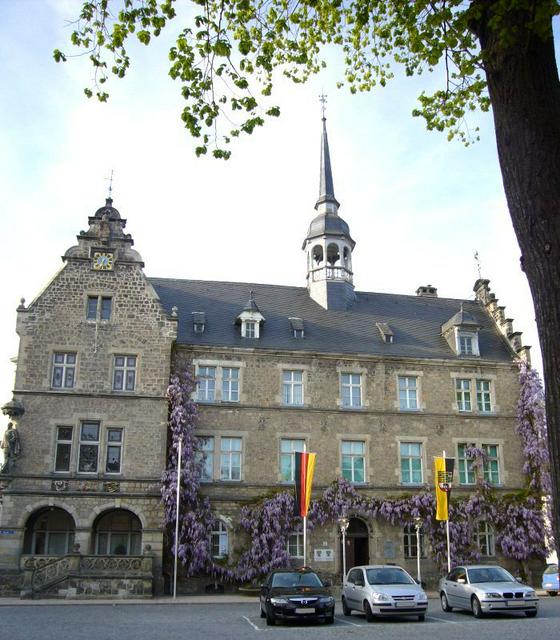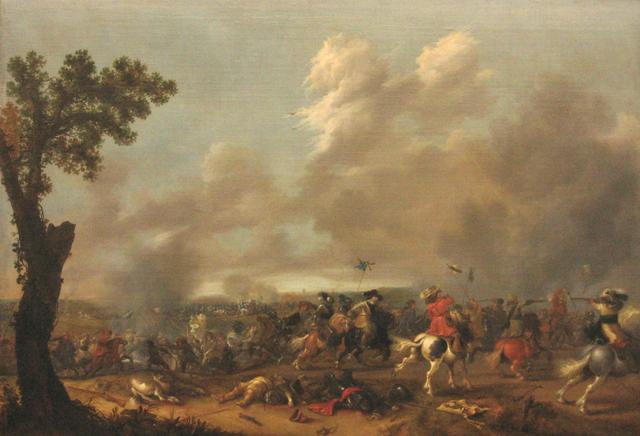 Lützen is a town with about 3600 inhabitants in Saxony-Anhalt in Germany.
Lützen is a town with about 3600 inhabitants in Saxony-Anhalt in Germany.
 Two great battles has been fought near the town.
Two great battles has been fought near the town.
The 1632 Battle of Lützen was part of the Thirty Years War. King Gustavus Adolphus led Sweden to victory against the Habsburg army, but died on the battlefield.
The 1813 Battle of Lützen was part of the Napoleonic Wars.
- Gustavus Adolphus memorial, Gustav-Adolf-Straße 42 (2km from the town center along the road towards Leipzig, +49 34444 203-17. Tue-Sun 10-17. The Swedish king Gustavus II Adolphus died in the battle of 1632, therefore most of the tourists visiting the town are Swedes. Initially the memorial just consisted of a granite boulder placed at the place where the fallen king's body was found. During a revival of veneration for Gustavus Adolphus in 19th-century Protestant Prussia, a baldachin designed by Karl Friedrich Schinkel (architect of many representative buildings in central Berlin) was added in 1833. The neighbouring Gustavus Adolphus chapel was endowed by the Swedish consul to Germany in 1907. There was an urban legend in East Germany that the memorial was an extraterritorial enclave of the Kingdom of Sweden, but there is no truth in it.
- Lützen castle, Schlossstraße 4, +49 34444 202-28. Tue-Sun 10-17. 13th-century castle built for the bishops of Merseburg. It hosts a museum of local and regional history, focusing on the two battles.
- The town hall, Markt 1. Built in 1884/1885, Renaissance revival style.
,_the_birthplace_of_Friedrich_Nietzsche-kJYHS.medium.jpg)
- Friedrich Nietzsche's birthplace, Röcken, Teichstraße 8 (2.5 km southwest of the town core, on the road to Weißenfels, +49 34444 169705. November–March: Wed-Sat 10AM-4PM, occasionally opened on Sundays and holidays (see website). World-famous philosopher Friedrich Nietzsche (1844–1900) was born in the parsonage of Röcken (as his father was the Lutheran pastor of that village). The father died when young Friedrich was five and the family moved to nearby Naumburg where there is a more comprehensive Nietzsche museum and archive. The memorial complex consists of the birth house, the church where Nietzsche was christened, his tomb and a modern group of sculptures ("Bacchanal"). The small exhibition (three rooms) was modernised in 2003 and deals with his childhood, his relationship with Christianity, and the history of his tomb.
Gustavus Adolphus memorial, Gustav-Adolf-Straße 42 (2km from the town center along the road towards Leipzig, +49 34444 203-17. Tue-Sun 10-17. The Swedish king Gustavus II Adolphus died in the battle of 1632, therefore most of the tourists visiting the town are Swedes. Initially the memorial just consisted of a granite boulder placed at the place where the fallen king's body was found. During a revival of veneration for Gustavus Adolphus in 19th-century Protestant [[Prussia]], a baldachin designed by Karl Friedrich Schinkel (architect of many representative buildings in [[Berlin/Mitte|central Berlin]]) was added in 1833. The neighbouring Gustavus Adolphus chapel was endowed by the Swedish consul to Germany in 1907. There was an urban legend in East Germany that the memorial was an extraterritorial enclave of the Kingdom of Sweden, but there is no truth in it.
Lützen castle, Schlossstraße 4, +49 34444 202-28. Tue-Sun 10-17. 13th-century castle built for the bishops of Merseburg. It hosts a museum of local and regional history, focusing on the two battles.
The town hall, Markt 1. Built in 1884/1885, Renaissance revival style.
Friedrich Nietzsche's birthplace, Röcken, Teichstraße 8 (2.5 km southwest of the town core, on the road to Weißenfels, +49 34444 169705. November–March: Wed-Sat 10AM-4PM, occasionally opened on Sundays and holidays (see website). World-famous philosopher Friedrich Nietzsche (1844–1900) was born in the parsonage of Röcken (as his father was the Lutheran pastor of that village). The father died when young Friedrich was five and the family moved to nearby [[Naumburg]] where there is a more comprehensive Nietzsche museum and archive. The memorial complex consists of the birth house, the church where Nietzsche was christened, his tomb and a modern group of sculptures ("Bacchanal"). The small exhibition (three rooms) was modernised in 2003 and deals with his childhood, his relationship with Christianity, and the history of his tomb.
There are no souvenir shops in Lützen.
- Roter Löwe, Ernst-Thälmann-Straße 9, +49 34444 23332.
Roter Löwe, Ernst-Thälmann-Straße 9, +49 34444 23332.
- Central German lake district, recultivated landscape of former lignite open-cast mines turned into lakes: Kulkwitzer See is 10 km northeast, Zwenkauer See 13 km east, Raßnitzer See 15 km north of Lützen
Central German lake district, recultivated landscape of former lignite open-cast mines turned into lakes: Kulkwitzer See is 10 km northeast, Zwenkauer See 13 km east, Raßnitzer See 15 km north of Lützen
- Leipzig, 20 km northeast, trade city, cultural metropolis and economic "boom town" of East Germany, the obviuos next step for history buffs is the Monument to the Battle of the Nations
- Merseburg, 20 km northwest, more than thousand-year-old town with interesting old centre, Romanesque/Gothic cathedral and Renaissance palace, long-standing chemical industry site
- Naumburg, 35 km southwest, impressive Romanesque cathedral, Friedrich Nietzsche museum and archive, centre of the Saale-Unstrut cultural landscape and wine-growing region
- Halle, 40 km north, largest city in Saxony-Anhalt, interesting old town, birthplace of George Frideric Handel, castles on the river Saale
